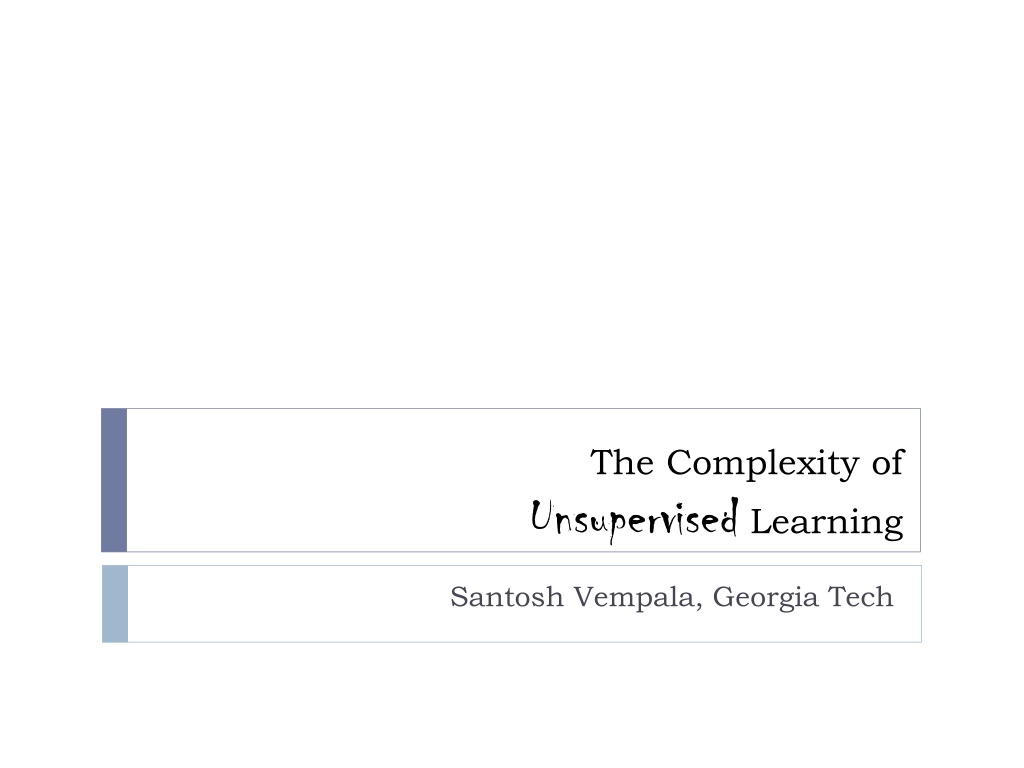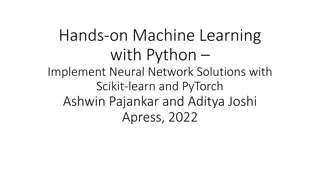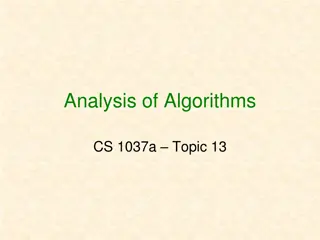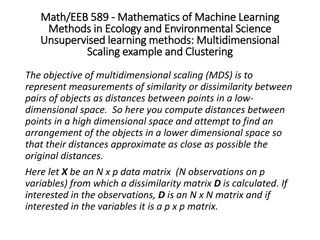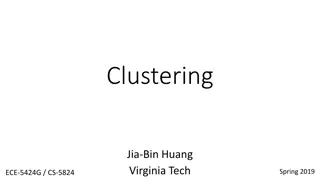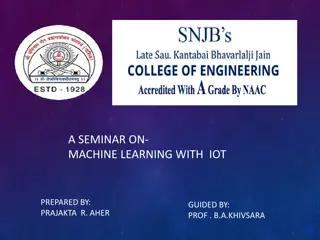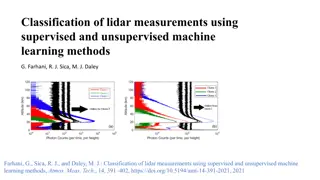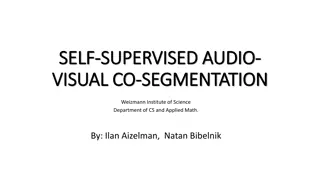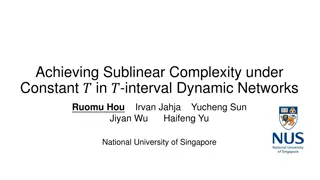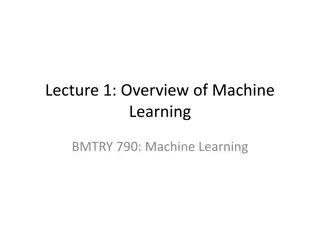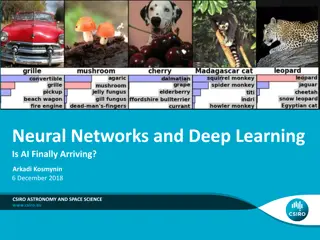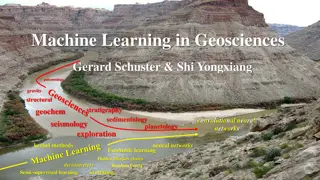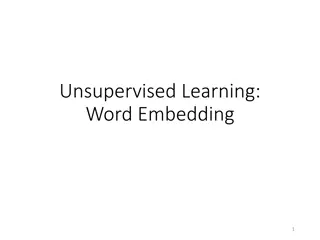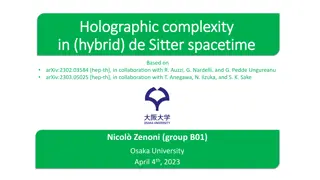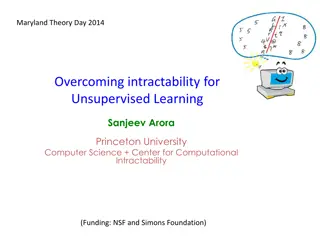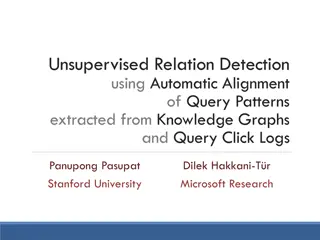Unsupervised Learning: Complexity and Challenges
Explore the complexities and challenges of unsupervised learning, diving into approaches like clustering and model fitting. Discover meta-algorithms like PCA, k-means, and EM, and delve into mixture models, independent component analysis, and more. Uncover the excitement of machine learning for the next century with a focus on understanding how the cortex learns and tackling general problems with mathematical appeal.
Download Presentation

Please find below an Image/Link to download the presentation.
The content on the website is provided AS IS for your information and personal use only. It may not be sold, licensed, or shared on other websites without obtaining consent from the author.If you encounter any issues during the download, it is possible that the publisher has removed the file from their server.
You are allowed to download the files provided on this website for personal or commercial use, subject to the condition that they are used lawfully. All files are the property of their respective owners.
The content on the website is provided AS IS for your information and personal use only. It may not be sold, licensed, or shared on other websites without obtaining consent from the author.
E N D
Presentation Transcript
The Complexity of Unsupervised Learning Santosh Vempala, Georgia Tech
Unsupervised learning Data is no longer the constraint in many settings (imagine sophisticated images here) But, How to understand it? Make use of it? What data to collect? with no labels (or teachers)
Can you guess my passwords? GMAIL GMAIL MU47286
Two general approaches Clustering Choose objective function or other quality measure of a clustering Design algorithm to find (near-)optimal or good clustering Check/hope that this is interesting/useful for the data at hand 1. Model fitting Hypothesize model for data Estimate parameters of model Check that parameters where unlikely to appear by chance (even better): find best-fit model ( agnostic ) 2.
Challenges Both approaches need domain knowledge and insight to define the right problem Theoreticians prefer generic problems with mathematical appeal Some beautiful and general problems have emerged. These will be the focus of this talk. There s a lot more to understand, that s the excitement of ML for the next century! E.g., How does the cortex learn? Much of it is (arguably) truly unsupervised ( Son, minimize the sum-of-squared-distances, is not a common adage)
Meta-algorithms PCA k-means EM Can be used on most problems. But how to tell if they are effective? Or if they will converge in a reasonable number of steps? Do they work? When? Why?
This talk Mixture Models Independent Component Analysis Finding Planted Structures Many other interesting and widely studied models: topic models, hidden Markov models, dictionaries, identifying the relevant ( feature ) subspace, etc.
Mixture Models Classify unlabeled samples from a unknown mixture of distributions; Learn parameters of the mixture. ? = ?1?1+ ?2?2+ + ???? E.g., each component ??is an unknown Gaussian, an unknown logconcave distribution, etc. Classification needs components to be well-separated. Learning Gaussian mixtures does not: Thm: Gaussian mixtures have unique decompositions.
Status: Learning parameters with no assumptions For any fixed k (number of Gaussians), there is a polynomial algorithm for learning a mixture of Gaussians up to a desired accuracy [Kalai-Moitra-Valiant, Belkin-Sinha, Moitra-Valiant] Sample Complexity: ?? ?. Known lower bound: 2? Open Problem 1: Is there an ? ? ????(?) algorithm for learning Gaussian mixtures?
Techniques Random Projection [Dasgupta] Project mixture to a low-dimensional subspace to (a) make Gaussians more spherical and (b) preserve pairwise mean separation [Kalai] Project mixture to a random 1-dim subspace; learn the parameters of the resulting 1-d mixture; do this for a set of lines to learn the n-dimensional mixture! Method of Moments [Pearson] Finite number of moments suffice for 1-d Gaussians [Kalai-Moitra-Valiant] 6 moments suffice [B-S, M-V]
Status: Learning/Clustering with separation assumptions A1. Pairwise separation between means. (Clustering) Separation: ? [Dasgupta, D-Schulman, Arora-Kannan, V-Wang, K.-Salmasian-V, Achlioptas-McSherry] 1 4(??+ ??) where ?? 2= max variance of component ?. A2. Each mean is separated from the span of the previous means in this ordering. (Clustering) Separation: ???? ? . standard deviation along separating direction [Brubaker-V.] A3. Matrix of means has a bounded smallest singular value. This implies that each mean is separated from the span of the rest. (Learning) Spherical Gaussians: complexity grows as 1/poly(separation). [Hsu-Kakade, Goyal-V.-Xiao] OP2: Complexity of learning a mixture of arbitrary Gaussians with linearly independent means? OP3: Minimum separation required to efficiently cluster a mixture of (spherical) Gaussians?
Techniques PCA: Use PCA once [V-Wang] Use PCA twice [Hsu-Kakade] Eat chicken soup with rice; Reweight and use PCA [Brubaker-V., Goyal-V.-Xiao]
Polynomial Algorithms I: Clustering spherical Gaussians [VW02] Distance-based clustering: 1 4 needs separation that grows as ? PCA, then cluster: 1 4: |?? ??| > ? 1 4 Separation required grows as ? ?? log Projection to span of means preserves inter-mean distance and shrinks component Gaussians. Span(means) = PCA subspace of dim k ??+
PCA for spherical Gaussians Best line for 1 Gaussian? - Line through the mean Best k-subspace for 1 Gaussian? -Any k-subspace through the mean Best k-subspace for k Gaussians? -The k-subspace through all k means!
Mixtures of Nonisotropic, Logconcave Distributions [KSV04,AM05] Thm. PCA subspace is close to span of means. Separation required for classification: |?? ??| > ????(?) ??,???+ ??,??? log where ??,??? is the maximum directional variance 2
Crack my passwords GMAIL MU47286 AMAZON AMAZON RU27316
Limits of PCA Can fail for a mixture of 2 arbitrary Gaussians Algorithm is not affine-invariant or noise-tolerant. Any instance can be made bad by an affine transformation or a few bad points.
Clustering and PCA Apply PCA to embed in a low-dimensional subspace Run favorite clustering algorithm (e.g., k-means iteration) 1. 2. [K.-Kumar] Converges efficiently for k-means iteration under a natural pairwise separation assumption. (important to apply PCA before running k-means!)
Polynomial Algorithms II: Learning spherical Gaussians [HK] Make mixture isotropic (covariance = identity) 2. Construct 3thmoment tensor of means 3. Decompose tensor to recover means, then variances and mixing weights 1. ? ? ? ? = ???? ?? ??+ ? After isotropy, means are orthogonal: 2 ? ? ? = ???? ??+ ???? ? ? ? 3rdmoment tensor has unique decomposition, can be found by a power iteration. Complexity grows as inverse polynomial in separation --- smallest singular value of mean matrix Fourier PCA [GVX13] also works (and with Gaussian noise)
Status: Noisy mixtures Gaussian mixture + small fraction of arbitrary points. Previous algorithms fail. PCA is not noise-tolerant! Mixture of logconcave distributions can be learned with a log ? factor extra pairwise separation, for noise ? = ? ???? [Brubaker] Technique: Outlier removal interleaved with PCA.
Polynomial Algorithms III: Robust PCA for noisy mixtures [Brubaker09] Remove points outside a ball. Project to top ?+? Repeat until dimension becomes k. 1. principal components. 2. 2 3. Thm. Robust PCA classifies logconcave mixtures, provided: 3 2 ????(??,???+ ??,???) log ? ?? ???? log2 for ? < |?? ??| > ?? ???? ???? Similar to [KSV04] but with extra log factor.
Classifying Arbitrary Gaussian Mixtures Component Gaussians must be probabilistically separated for classification to be possible OP4: Is this enough? Probabilistic separation is affine invariant: PCA is not affine-invariant!
Polynomial Algorithms IV: Affine-invariant clustering [BV08] Make distribution isotropic. Reweight points (using a Gaussian). If mean shifts, partition along this direction; Recurse. Otherwise, partition along top principal component; Recurse. 1. 2. 3. 4. Thm. The algorithm correctly classifies samples from a mixture of k arbitrary Gaussians if each one is separated from the span of the rest. (More generally, if the overlap is small as measured by the Fisher criterion). OP4: Extend Isotropic PCA to logconcave mixtures.
Unraveling Gaussian Mixtures Isotropy pulls apart the components 2 5 1.5 4 1 3 0.5 2 0 1 -0.5 0 -1 -1 -1.5 -2 -2 -3 -2 -1 0 1 2 -5 -4 -3 -2 -1 0 1 2 3 4 5 If some component is heavier, then reweighted mean shifts along a separating direction If not, reweighted principal component is along a separating direction
Original Data 1 0.5 0 -0.5 -1 -1.5 -1 -0.5 0 0.5 1 1.5 40 dimensions, 15000 samples (subsampled for visualization)
Random Projection 2 1 0 -1 -2 -3 -3 -2 -1 0 1 2 3 26
PCA 4 3 2 1 0 -1 -2 -3 -4 -4 -2 0 2 4 6 27
Isotropic PCA 1.5 1 0.5 0 -0.5 -1 -0.5 0 0.5 1 1.5 28
Crack my passwords GMAIL MU47286 AMAZON RU27316 IISC IISC LH857
Independent Component Analysis [Comon] Model: Data is a linear transformation of an unknown product distribution: ? ??,? ?? ? data ? = ?? A is unique up to signs of columns if at most one component ?? is Gaussian Problem: Learn A by observing samples x. Used extensively in ML, signal processing, neuroscience etc. for 25+ years. Many attractive heuristics.
ICA model Start with a product distribution
ICA model Apply a linear transformation A
ICA model Observed sample
ICA model Matrix A might include a projection (underdetermined ICA)
Status: ICA Thm [GVX13]. If columns of A satisfy a weak linear independence condition, and component distributions satisfy |?????(??)| > for ?? ?, then A can be estimated with complexity ???? ??, ,1 ?. Generalized linear independence: smallest d for which the tensors ??? are linearly independent. Earlier work for d=1 and k=4 [FJK,NR,AGMS,AGR] Thm[VX14]. If columns of A are linearly independent and ? 4, then sample complexity = ? ? and time complexity = O(SVD) Both theorems work with Gaussian noise: ? = ?? + ? OP5: ICA with arbitrary noise?
Techniques PCA finds local optima of second moments, i.e., max 2) ? ??? (??? Local optima of 4th moment. [Frieze-Jerrum-Kannan96] Works if each component differs from Gaussian in the 4th moment, e.g., uniform over a cube. Local optima via local search or a power iteration. [Nguyen-Regev] Tensor view: After making the samples isotropic, ? ? ? ? ? = ?(? ?? 4 3)?? ?? ?? ?? Fourier PCA [GVX13]. Reweight ? with Fourier weight ????? for random unit vector ?; then apply PCA; more generally, a robust tensor decomposition. Recursive FPCA [VX14]. Partition using largest eigenvalue gap; recurse.
ICA Algorithm: Tensor decomposition of Fourier derivative tensors ??? = log? ????? ? ??????? ???? = = ?? ? ????? ? ?? ? ???????? ? ?2??? = ? ????? ?2??(???)? ? ???? If ? = ??, ?2??? ?? = ? ???? 2 More generally, ?2?????? ? ?2???? = ?? ???? ??? 2? ? ????
Tensor decomposition [GVX13] ?2?????? ? ?2???? = ?? ???? ??? 2? ? ???? Tensor decomposition needed to recover columns of A! Power iteration works if A is unitary, so ? ?. Hard for one tensor, but with two such tensors generated with two random Fourier weights, we get ?? 2???, ?? 2??? ??= ??= ? ? Then compute eigenvectors of ???? 1= ?? ???? ?? ?? ??? Need only that ?? ?? are distinct --- which holds whp.
Analysis Use Taylor decomposition ???(??) = ? ??? ?! ??????? Truncate, analyze random Gaussian polynomials. Concentration and Anti-concentration
Crack my passwords GMAIL MU47286 AMAZON RU27316 IISC LH857 SHIVANI SHIVANI HQ508526
Planted problems Problems over distributions. Base distribution is a random discrete structure, e.g., a random graph or a random Boolean formula. An unlikely substructure is planted, e.g., a large clique or a planted assignment --- the distribution is over structures random but subject to containing the planted substructure. Problem: Recover planted substructure.
Planted structures Planted clique: Start with a random graph. Add a clique of size ? 2log? on some subset of k vertices. Find planted clique. Planted partition: Fix a partition of vertices of a graph. Pick random edges with different probabilities within parts and across parts. Recover planted partition. Planted assignment: Fix an assignment ? on Boolean variables. Generate a random formulas by picking clauses from a distribution that depends on ?. Recover planted assignment. Planted vector/subspace: Generate random points by adding a random vector from a fixed subspace to random (Gaussian) noise in full space. Recover planted vector subspace
Status: Planted Cliques Upper bounds: ?? log ? for any ? > 2 + ? log? Polynomial time for ? > ? ? [many] Lower bound: For ? > 0, ? = ?0.5 ?, any statistical algorithm has complexity ? log ? [Grigorescu-Reyzin-Feldman-V.-Xiao13] (formally, this is for bipartite planted cliques, for which the same upper bounds apply) ? OP6: Is there a polytime algorithm for ? = ? log ? ?
Techniques Combinatorial: Remove lowest degree vertex iteratively [Feige] Spectral: Take highest components of principal component [AKS98] 1 1 1/-1 = 0 + 1/-1 A E(A) R Thm [Furedi-Komlos]. |?|2 2 + ? 1 ?.
Status: Planted k-SAT/k-CSP Upper bound: Information theoretically, ?(?log?) clauses suffice. Algorithmically, ??/2log? clauses suffice [Bogdanov-Qiao-Applebaum, Feldman-Perkins-V.14] in time linear in number of clauses [FPV14]. Bound is ??/2 for (r-1)-wise independent clause distributions. Lower bound: ? log ? ?/2 clauses for statistical algorithms.[FPV14] OP7: Find more efficient nonstatistical algorithm for planted SAT.
Techniques Combinatorial + SDP for even k. [A12, BQ09] Subsampled power iteration: works for any k and a more general hypergraph planted partition problem: [FPV14] Stochastic block theorem for k=2 (graph partition): a precise threshold on edge probabilities for efficiently recoverability. [Decelle-Krzakala-Moore-Zdeborova11] [Massoulie13, Mossel-Neeman-Sly13].
Algorithm: Subsampled Power Iteration Reduce to bipartite stochastic block model When k is odd, the norm of the noise dominates the signal, so usual analysis does not work! Form ??/2 ??/2 matrix, sample into random submatrices, then use in a power iteration, starting with a random ?0. Keep track of signs of iterate ?? and take majority vote after ?(log?) iterations.
Problems over distributions ?: set of distributions over domain X F : set of solutions to problem ?:? ??: valid solutions for each input dist. Problem: given access to random samples from some distribution D in D, find a solution f in Z(D). Average of a function: ???(?) Principal component: Find ???? =1 ??[ ???2] What fraction of input distribution satisfies property P? ?? ???? ??? ?? LP: max ?? ?? ?,? OR max u u
